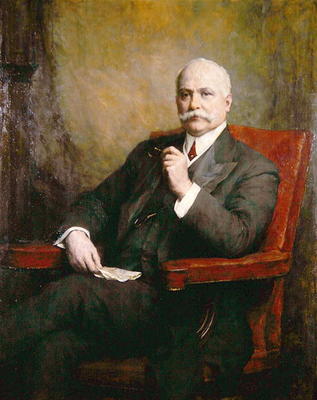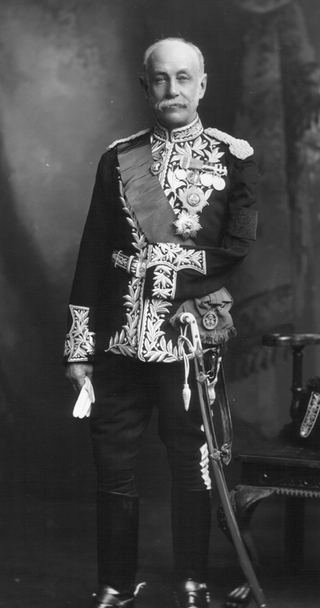Related Research Articles

Baron Rothschild, of Tring in the County of Hertfordshire, is a title in the Peerage of the United Kingdom. It was created in 1885 for Sir Nathan Rothschild, 2nd Baronet, a member of the Rothschild banking family. He was the first Jewish member of the House of Lords not to have previously converted to Christianity. The current holder of the title is Nathaniel Rothschild, 5th Baron Rothschild, who inherited the barony in February 2024.
Baron Renwick, of Coombe in the County of Surrey, is a title in the Peerage of the United Kingdom. It was created on 23 December 1964 for the businessman and public servant, Sir Robert Renwick, 2nd Baronet. He notably worked for the Air Ministry and the Ministry of Aircraft Production during the Second World War. The Renwick Baronetcy, of Coombe in the County of Surrey, was created in the Baronetage of the United Kingdom on 28 June 1927 for his father, Harry Renwick. As of 2020 the titles are held by the first Baron's grandson, the third Baron, who succeeded in that year. The second baron was active in the House of Lords until the House of Lords Act 1999, when he lost his seat in parliament.
Two baronetcies with the surname Arbuthnot have been created for members of the Arbuthnot family—both in the Baronetage of the United Kingdom, and still extant.

There have been five baronetcies created for people with the surname Pollock, one in the Baronetage of Nova Scotia and four in the Baronetage of the United Kingdom. As of 2017 three of the creations are extant. These three creations derive from the same family to which the 1703 baronetcy was granted; the Pollock ancestor of Sir Frederick Pollock, 1st Baronet and Sir George Pollock, 1st Baronet married his cousin, daughter of Sir Robert Pollock, 2nd Baronet.
There have been four baronetcies created for persons with the surname Leslie, one in the Baronetage of Nova Scotia, one in the Baronetage of Ireland, one in the Baronetage of Great Britain and one in the Baronetage of the United Kingdom. Three of the creations are extant as of 2010.

There have been three baronetcies created for persons with the surname Holden, all in the Baronetage of the United Kingdom. Two of the creations are extant as of 2010.

There have been two baronetcies created for members of the Waterlow family, both in the Baronetage of the United Kingdom. Both titles are extant as of 2010.
The Oakshott Baronetcy, of Bebington in the County Palatine of Chester, is a title in the Baronetage of the United Kingdom. It was created on 10 July 1959 for the Hendrie Oakshott, Conservative Member of Parliament for Bebington. In 1964 he was further honoured when he was created a life peer as Baron Oakshott, of Bebington in the County Palatine of Chester. The life barony became extinct on his death in 1975 while he was succeeded in the baronetcy by his eldest son, the second Baronet. As of 2014 the title is held by the first Baronet's grandson, who succeeded in 2014.
There have been two baronetcies created for persons with the surname Bates, both in the Baronetage of the United Kingdom. As of 2014 both creations are extant.
There have been two baronetcies created for persons with the surname Cave, one in the Baronetage of England and one in the Baronetage of the United Kingdom. Both creations are extant as of 2008.

There have been three baronetcies created for members of the Blakiston family of Blakiston, County Durham, two in the Baronetage of England and one in the Baronetage of Great Britain. One creation is extant as of 2008.

There have been twenty one baronetcies created for persons with the surname Williams, eight in the Baronetage of England, three in the Baronetage of Great Britain and ten in the Baronetage of the United Kingdom. Only six of the creations are extant as of 2017.

There have been two baronetcies created for persons with the surname Bradford, both in the Baronetage of the United Kingdom.

There have been nine baronetcies created for persons with the surname Cooper, one in the Baronetage of England, one in the Baronetage of Ireland and seven in the Baronetage of the United Kingdom.

There have been eight baronetcies created for persons with the surname Wilson, one in the Baronetage of Ireland and six in the Baronetage of the United Kingdom.
The Cotts Baronetcy, of Coldharbour Wood in the parish of Rogate in the County of Sussex, is a title in the Baronetage of the United Kingdom. It was created on 15 June 1921 for Sir William Cotts, KBE. He was head of Mitchell Cotts and Co, of London, and of allied companies, merchants, colliery proprietors and steamship owners, and also briefly represented Western Isles in the House of Commons as a National Liberal. The second Baronet assumed by deed poll the additional surname of Mitchell in 1932. He was an actor, writer, journalist, and publisher.
There have been two baronetcies created for persons with the surname Reynolds, both in the Baronetage of the United Kingdom. One creation is extant as of 2007.
There have been four baronetcies created for persons with the surname Temple, two in the Baronetage of England, one in the Baronetage of Nova Scotia and one in the Baronetage of the United Kingdom.
The Holder Baronetcy, of Pitmaston, in the Parish of Moseley, in the County of Worcester, is a title in the Baronetage of the United Kingdom. It was created on 10 March 1898 for John Holder.

The Ferguson Davie Baronetcy, of Creedy in the County of Devon, is a title in the Baronetage of the United Kingdom. It was created on 9 January 1847 for Henry Ferguson Davie, a General in the Army and Member of Parliament for Haddington from 1847 to 1878. Born Henry Ferguson, he was the husband of Frances Juliana Davie, only surviving sister of Sir John Davie, 9th Baronet, of Creedy, and niece and heiress of Sir Humphrey Davie, 10th Baronet, of Creedy. In 1846 he assumed by Royal licence the additional surname of Davie. The second Baronet represented Barnstaple in the House of Commons as a Liberal.
References
- ↑ "No. 43373". The London Gazette . 3 July 1964. p. 5723.
- ↑ "No. 43378". The London Gazette . 10 July 1964. p. 5988.
- ↑ Debrett's Peerage. 2000.
- Kidd, Charles, Williamson, David (editors). Debrett's Peerage and Baronetage (1990 edition). New York: St Martin's Press, 1990.
- Leigh Rayment's list of baronets